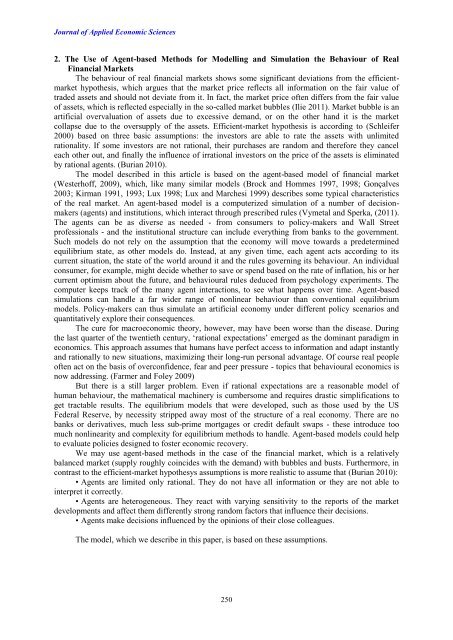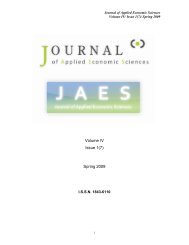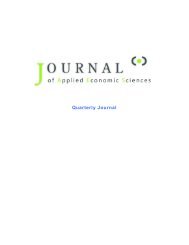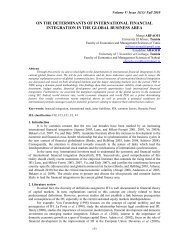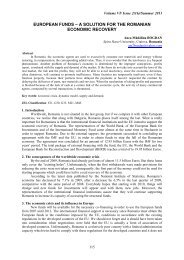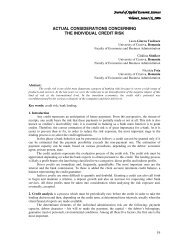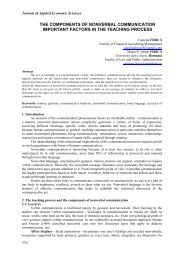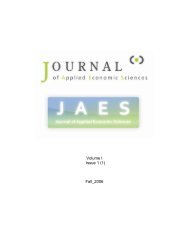financial market simulation based on intelligent agents â case study
financial market simulation based on intelligent agents â case study
financial market simulation based on intelligent agents â case study
You also want an ePaper? Increase the reach of your titles
YUMPU automatically turns print PDFs into web optimized ePapers that Google loves.
Journal of Applied Ec<strong>on</strong>omic Sciences2. The Use of Agent-<str<strong>on</strong>g>based</str<strong>on</strong>g> Methods for Modelling and Simulati<strong>on</strong> the Behaviour of RealFinancial MarketsThe behaviour of real <str<strong>on</strong>g>financial</str<strong>on</strong>g> <str<strong>on</strong>g>market</str<strong>on</strong>g>s shows some significant deviati<strong>on</strong>s from the efficient<str<strong>on</strong>g>market</str<strong>on</strong>g>hypothesis, which argues that the <str<strong>on</strong>g>market</str<strong>on</strong>g> price reflects all informati<strong>on</strong> <strong>on</strong> the fair value oftraded assets and should not deviate from it. In fact, the <str<strong>on</strong>g>market</str<strong>on</strong>g> price often differs from the fair valueof assets, which is reflected especially in the so-called <str<strong>on</strong>g>market</str<strong>on</strong>g> bubbles (Ilie 2011). Market bubble is anartificial overvaluati<strong>on</strong> of assets due to excessive demand, or <strong>on</strong> the other hand it is the <str<strong>on</strong>g>market</str<strong>on</strong>g>collapse due to the oversupply of the assets. Efficient-<str<strong>on</strong>g>market</str<strong>on</strong>g> hypothesis is according to (Schleifer2000) <str<strong>on</strong>g>based</str<strong>on</strong>g> <strong>on</strong> three basic assumpti<strong>on</strong>s: the investors are able to rate the assets with unlimitedrati<strong>on</strong>ality. If some investors are not rati<strong>on</strong>al, their purchases are random and therefore they canceleach other out, and finally the influence of irrati<strong>on</strong>al investors <strong>on</strong> the price of the assets is eliminatedby rati<strong>on</strong>al <strong>agents</strong>. (Burian 2010).The model described in this article is <str<strong>on</strong>g>based</str<strong>on</strong>g> <strong>on</strong> the agent-<str<strong>on</strong>g>based</str<strong>on</strong>g> model of <str<strong>on</strong>g>financial</str<strong>on</strong>g> <str<strong>on</strong>g>market</str<strong>on</strong>g>(Westerhoff, 2009), which, like many similar models (Brock and Hommes 1997, 1998; G<strong>on</strong>çalves2003; Kirman 1991, 1993; Lux 1998; Lux and Marchesi 1999) describes some typical characteristicsof the real <str<strong>on</strong>g>market</str<strong>on</strong>g>. An agent-<str<strong>on</strong>g>based</str<strong>on</strong>g> model is a computerized <str<strong>on</strong>g>simulati<strong>on</strong></str<strong>on</strong>g> of a number of decisi<strong>on</strong>makers(<strong>agents</strong>) and instituti<strong>on</strong>s, which interact through prescribed rules (Vymetal and Sperka, (2011).The <strong>agents</strong> can be as diverse as needed - from c<strong>on</strong>sumers to policy-makers and Wall Streetprofessi<strong>on</strong>als - and the instituti<strong>on</strong>al structure can include everything from banks to the government.Such models do not rely <strong>on</strong> the assumpti<strong>on</strong> that the ec<strong>on</strong>omy will move towards a predeterminedequilibrium state, as other models do. Instead, at any given time, each agent acts according to itscurrent situati<strong>on</strong>, the state of the world around it and the rules governing its behaviour. An individualc<strong>on</strong>sumer, for example, might decide whether to save or spend <str<strong>on</strong>g>based</str<strong>on</strong>g> <strong>on</strong> the rate of inflati<strong>on</strong>, his or hercurrent optimism about the future, and behavioural rules deduced from psychology experiments. Thecomputer keeps track of the many agent interacti<strong>on</strong>s, to see what happens over time. Agent-<str<strong>on</strong>g>based</str<strong>on</strong>g><str<strong>on</strong>g>simulati<strong>on</strong></str<strong>on</strong>g>s can handle a far wider range of n<strong>on</strong>linear behaviour than c<strong>on</strong>venti<strong>on</strong>al equilibriummodels. Policy-makers can thus simulate an artificial ec<strong>on</strong>omy under different policy scenarios andquantitatively explore their c<strong>on</strong>sequences.The cure for macroec<strong>on</strong>omic theory, however, may have been worse than the disease. Duringthe last quarter of the twentieth century, ‘rati<strong>on</strong>al expectati<strong>on</strong>s’ emerged as the dominant paradigm inec<strong>on</strong>omics. This approach assumes that humans have perfect access to informati<strong>on</strong> and adapt instantlyand rati<strong>on</strong>ally to new situati<strong>on</strong>s, maximizing their l<strong>on</strong>g-run pers<strong>on</strong>al advantage. Of course real peopleoften act <strong>on</strong> the basis of overc<strong>on</strong>fidence, fear and peer pressure - topics that behavioural ec<strong>on</strong>omics isnow addressing. (Farmer and Foley 2009)But there is a still larger problem. Even if rati<strong>on</strong>al expectati<strong>on</strong>s are a reas<strong>on</strong>able model ofhuman behaviour, the mathematical machinery is cumbersome and requires drastic simplificati<strong>on</strong>s toget tractable results. The equilibrium models that were developed, such as those used by the USFederal Reserve, by necessity stripped away most of the structure of a real ec<strong>on</strong>omy. There are nobanks or derivatives, much less sub-prime mortgages or credit default swaps - these introduce toomuch n<strong>on</strong>linearity and complexity for equilibrium methods to handle. Agent-<str<strong>on</strong>g>based</str<strong>on</strong>g> models could helpto evaluate policies designed to foster ec<strong>on</strong>omic recovery.We may use agent-<str<strong>on</strong>g>based</str<strong>on</strong>g> methods in the <strong>case</strong> of the <str<strong>on</strong>g>financial</str<strong>on</strong>g> <str<strong>on</strong>g>market</str<strong>on</strong>g>, which is a relativelybalanced <str<strong>on</strong>g>market</str<strong>on</strong>g> (supply roughly coincides with the demand) with bubbles and busts. Furthermore, inc<strong>on</strong>trast to the efficient-<str<strong>on</strong>g>market</str<strong>on</strong>g> hypothesys assumpti<strong>on</strong>s is more realistic to assume that (Burian 2010):• Agents are limited <strong>on</strong>ly rati<strong>on</strong>al. They do not have all informati<strong>on</strong> or they are not able tointerpret it correctly.• Agents are heterogeneous. They react with varying sensitivity to the reports of the <str<strong>on</strong>g>market</str<strong>on</strong>g>developments and affect them differently str<strong>on</strong>g random factors that influence their decisi<strong>on</strong>s.• Agents make decisi<strong>on</strong>s influenced by the opini<strong>on</strong>s of their close colleagues.The model, which we describe in this paper, is <str<strong>on</strong>g>based</str<strong>on</strong>g> <strong>on</strong> these assumpti<strong>on</strong>s.250


